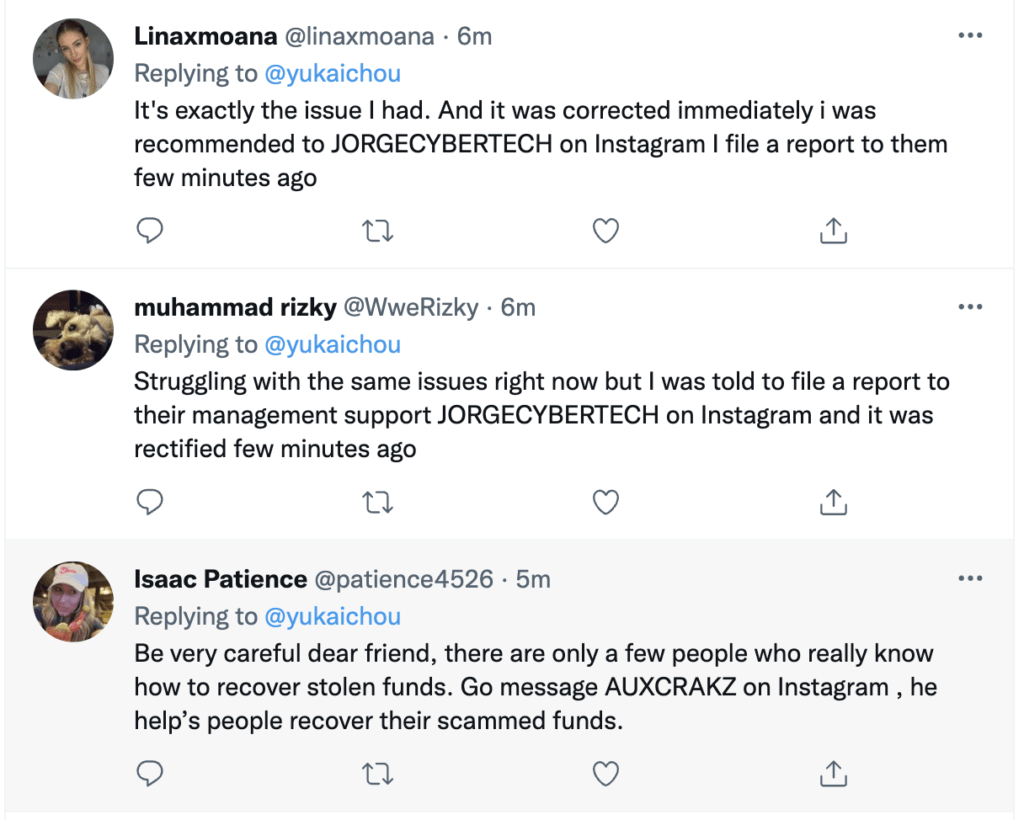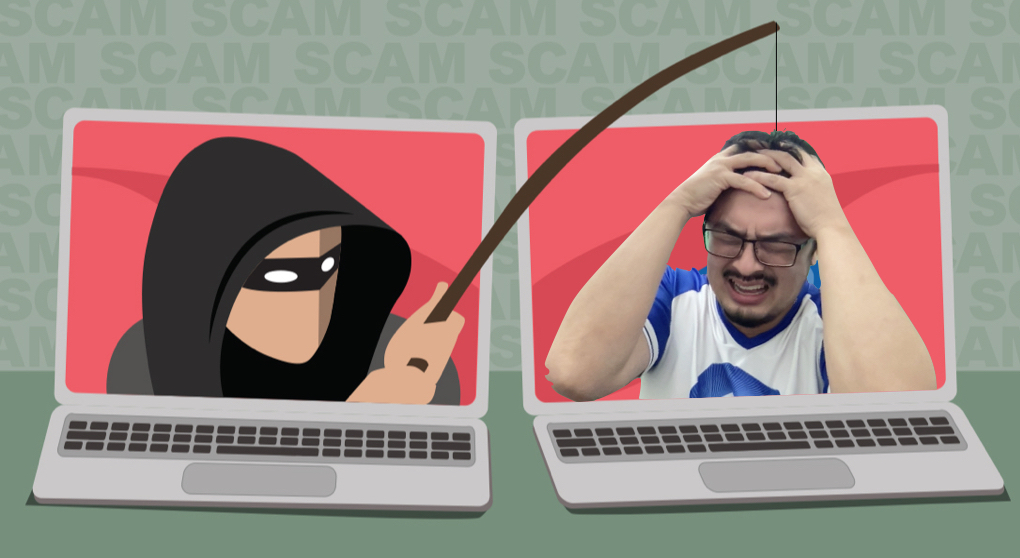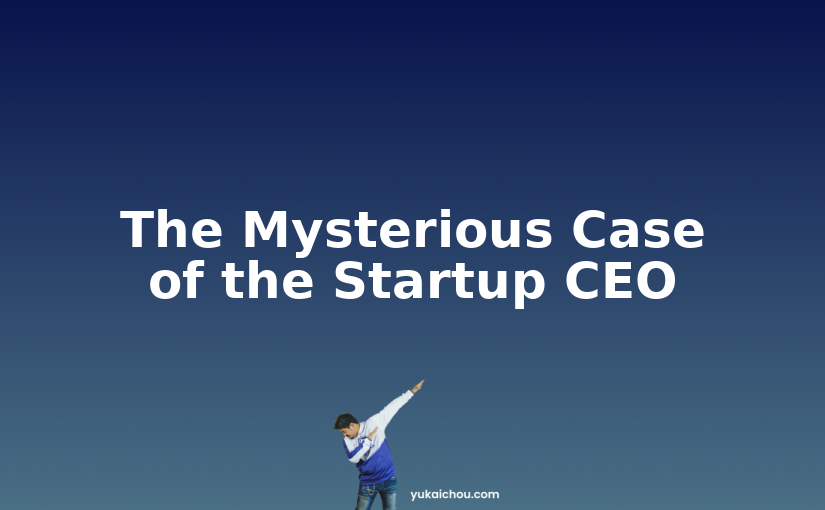I debated for a long time whether I should write this blogpost – because as a reputable known person, it’s extremely embarrassing. I had a lapse in intelligence and suffered humiliation and financial loss because of it.
However, I decided to write this because that’s how the Twitter Scammers get their way – people are too embarrassed to call them out so they keep scamming.
I wanted people who follow my work to avoid making idiotic mistakes that I make and prevent this terrible experience that I went through. So here you go:
Here’s the story of how I got scammed for the first time in my life (after fending off dozens of scammers), and the heartbreaking fact that Twitter wouldn’t even allow me to report the scammer (and hence, the scammer is still out there scamming people before my eyes).
Specifically, I got scammed by a person pretending to be a reputable YouTuber on Twitter and lost $400 as I pulled the plug right before losing more.
This post about the Twitter Scammer is broken into three sections:
- How I got scammed
- Why I couldn’t report this on Twitter
- Some lessons to avoid being scammed in the future
The pandemic of Twitter Scammers
Twitter scams are quite common. The fact that people can change their Twitter Handles and IDs very easily – while useful – also leads to scammers constantly changing their identities while having an account that seems to be long lasting and credible.
There’s also a ton of bots on Twitter, which allows fake profiles to look like they have a lot of followers. This is the reason why Elon Musk recently withdrew from his offer to buy Twitter.
But the craziest thing is, after an hour of trying, there is no valid way to report a scammer on Twitter (only other things), until I finally gave up.
Without anything else I could do while knowing that this Twitter Scammer is scamming other people constantly even right now, I decided to write this blogpost.
How I dodged a Blue Check Twitter Scammer
Even Blue-Checkmark Verified Twitter Accounts with over 100K followers and a ton of retweets can end up being a scammer.
Once, a Twitter account that pretended to be a cool-looking Japanese Woman reached out to me and said she would be happy to retweet my Web3 Memory Preservation Platform Metablox to her followers for a fee.
I looked at her profile, and she has a blue checkmark with 120K followers and around hundreds of retweets every tweet. Her profile looked cool and she said she loved traveling.
However, two red flags came about in the middle of the discussions. When I passed it off to my Cofounder Jun Loayza, who is half Japanese half Peruvian, he greeted her in Japanese.
She ignored his greeting and just went straight down to business in English. Jun noted, “She’s definitely fake. No Japanese person I’ve ever met ignores someone greeting them in Japanese.”
But I wanted to give “her” benefit of the doubt, so I continued the discussions. Until at one point, I was slow in my responses, and she sent a message, “Sir, can you reply to my message please?”
This was the second tell. Jun, who has managed customer service teams in the Philippines before, said, “Given her semi-aggressive and confident tone, it’s another red flag that she addresses you as ‘sir.” This has to be a worker from South East Asia.” Jun is a genius.
Being an empathetic person who generally trusted people, I still wasn’t sure, but to be careful, I stopped communicating.
Sure enough, a month later, this same profile changed names and pictures into a charismatic looking white man. That was proof beyond a doubt that this is a scammer.
At that point, I wanted to report the scammer to Twitter, but I didn’t find any option to do so in their menu.
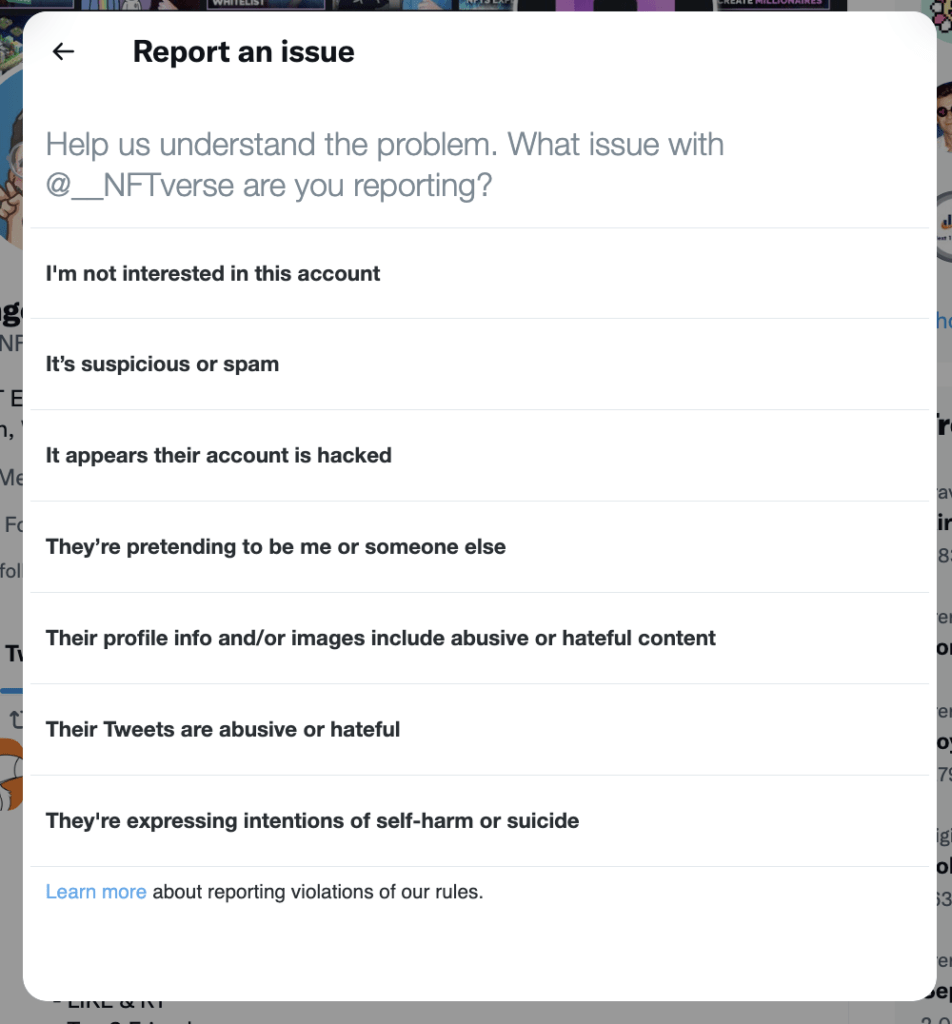
None of these options are that relevant. They didn’t hack someone else’s account. It’s not spam. It’s not abusive.
I tried “They’re pretending to be more or someone else.” But then the next box asks, “What’s the Twitter Account of the person they are impersonating and what’s the Full Name?”
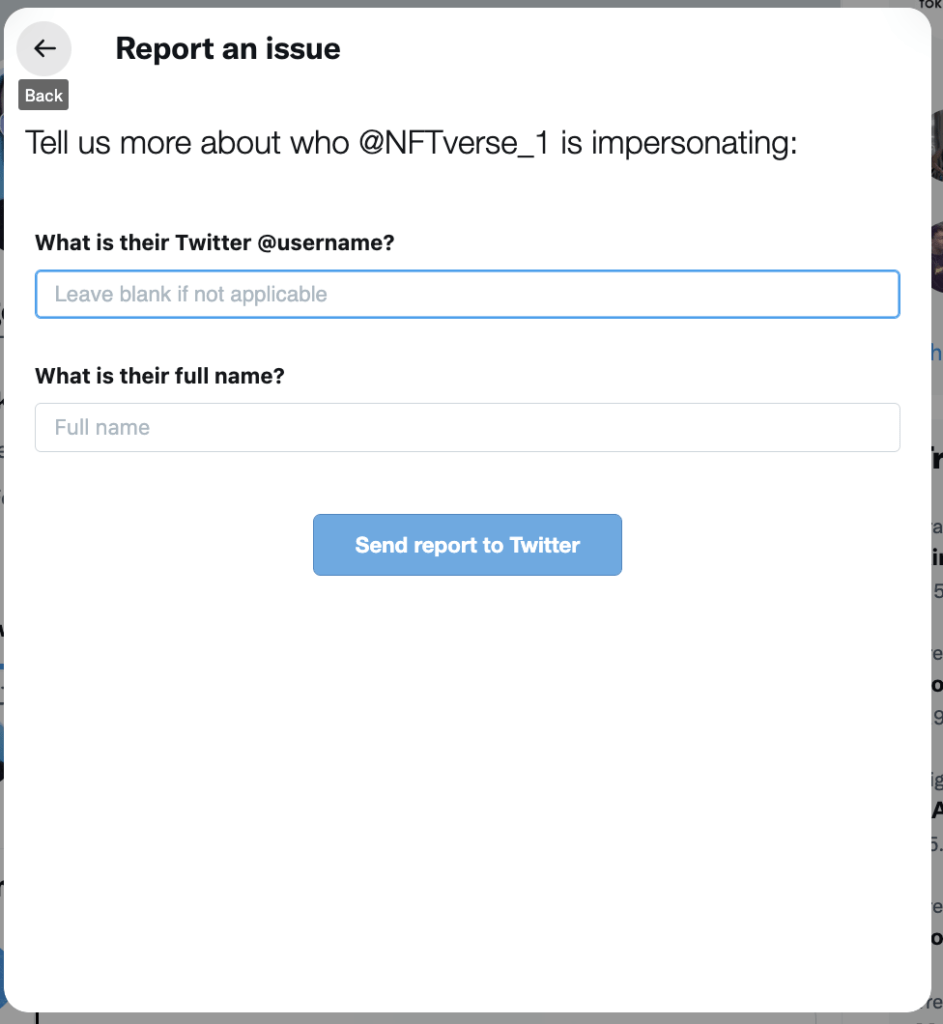
I have no idea.
After going through all the options (more on that later), and since I didn’t actually get scammed in this case, I gave up.
When the Twitter Scammer actually got me
Many months later, another YouTuber by the name of Angel reached out to me.
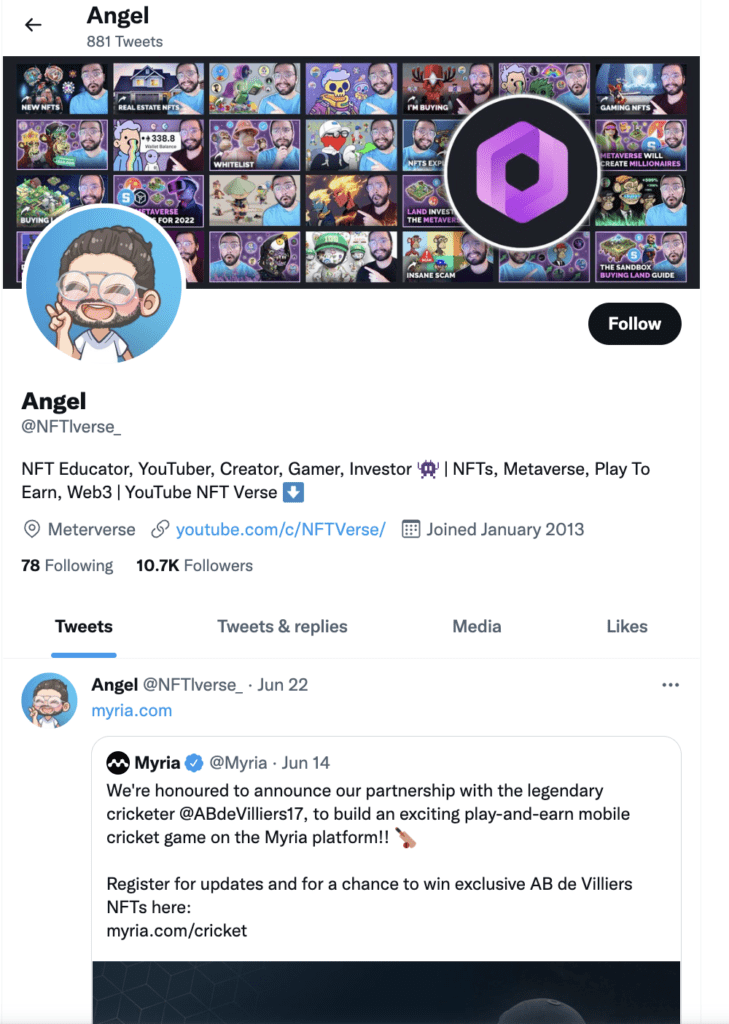
He said he loved my Web3 Game to Preserve Humanity’s most important memories – Metablox, as it combines real life memories with real world locations. He wants to create a video to feature it on his YouTube Channel.

I checked out his YouTube Channel and it looked legit. The Twitter Account was created since 2013, with over 10,000 followers. The YouTube account had over 140,000 subscribers with each video having around 8,000-12,000 views.

Not too small that it didn’t matter, but not too huge that it felt a bit unbelievable (like if GaryVee said he wanted to promote my platform).
Now at that point, I didn’t doubt him. A lot of people have been fans of my work with my book selling over 100K copies. A lot of people genuinely love the Metablox timeless concept of preserving our important memories onto the Blockchain.
Furthermore, the account talked like a cool dude and doesn’t seem to be an outsourced laborer.
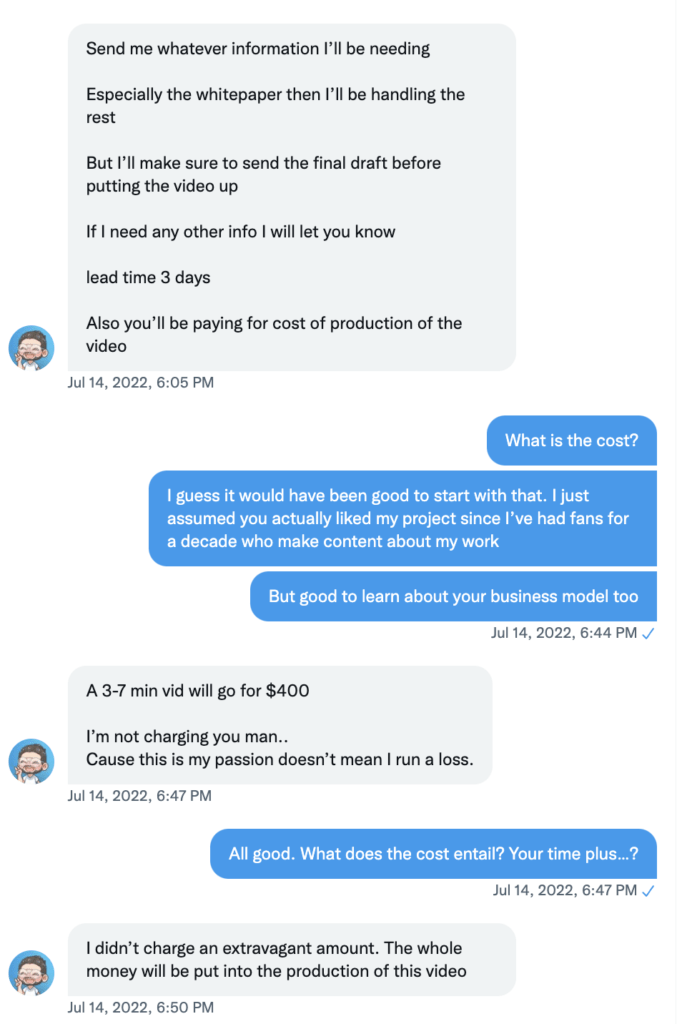
At that point, he brought up that I would need to cover the cost of making this video.
A bit annoyed, but I still asked what the price was.
He said it was $400 for a 3-7 min video. I asked him what kind of cost are we talking about besides his time. After all, as an YouTuber he makes regular videos on things he likes anyway.
He appeared a bit annoyed, saying, “Cause this is my passion doesn’t mean I run a loss.” and “The whole money will be put into the production of this video.”
I wasn’t interested in trapping him to admit that he was just looking to get a sponsored video, but thought for $400 it was worth a try to see what he could get. After all, I did very much want more people to learn about the Metablox vision.
So I paid him the $400 via Ethereum. I have to admit, my rush to paying him was due to Ether’s price surging to a quite high point at the time, and I felt I better pay him while the cryptocurrency was high instead of waiting for it to drop again (as the price is quoted in USD).
I asked him what are next steps, and he said to send him my Whitepaper and I should hear back in 3 days. So far everything seemed okay too.
The Twitter Scam’s Curve Ball Starts
After a few days, I checked in with him. He told me that Metablox was more complex than he thought and this should have been a 7-10 min video. He has deleted and restarted multiple times and it has been frustrating for him.
At that point, I wasn’t sure if he wanted to ask for more money, but I believed it wasn’t my problem that he misquoted me for his cost and wasted his efforts. I didn’t even know he wanted to charge me in the first place!
So I just said, “Ah interesting and unfortunate it created some frustration. Thanks for the update.” and he just replied, “Oh!” which I found really odd.
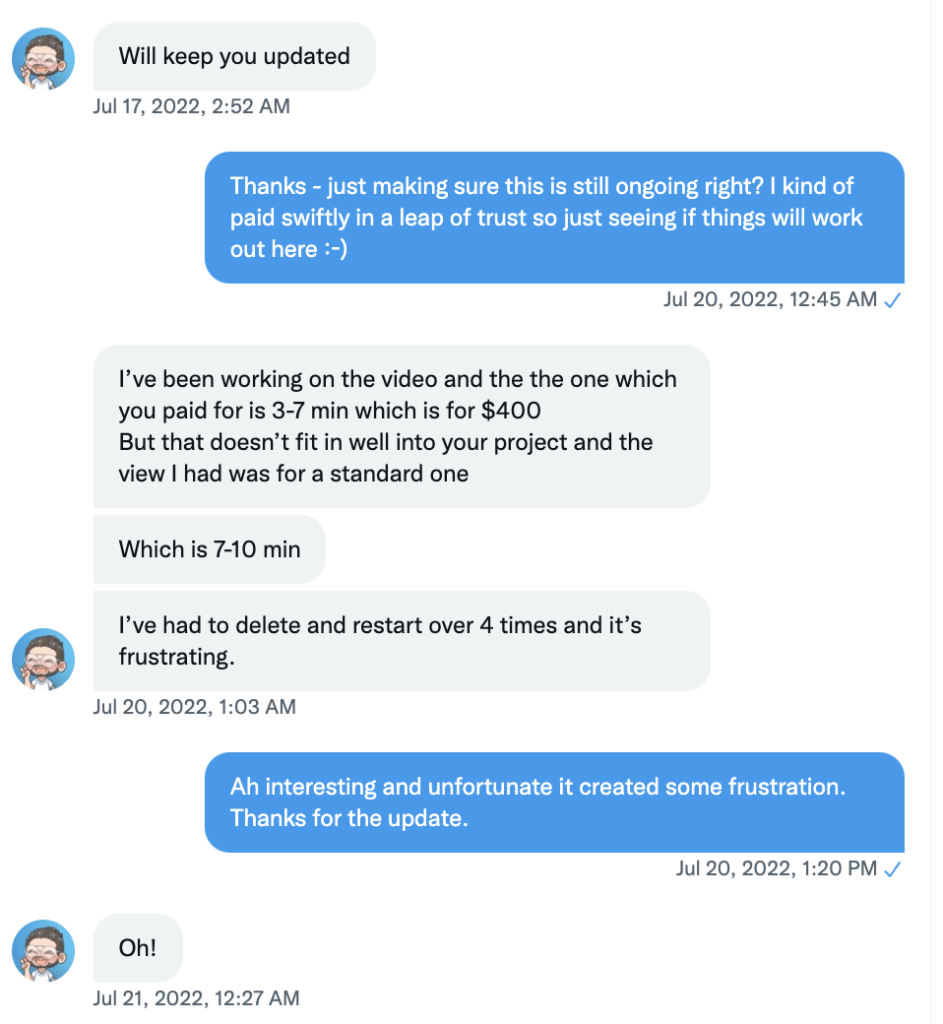
Almost 2 weeks later, I reached out to again to check with status. And that’s when he said (paraphrasing a little), “Like I said man, I already got a video but it’s a 7-10 min video. I already spent $1000 on making this, so I would need you to send the balance for me to send it in for final edits.”
That was the serious red flag for me. Someone who is upping the game of how much he wants without showcasing anything.
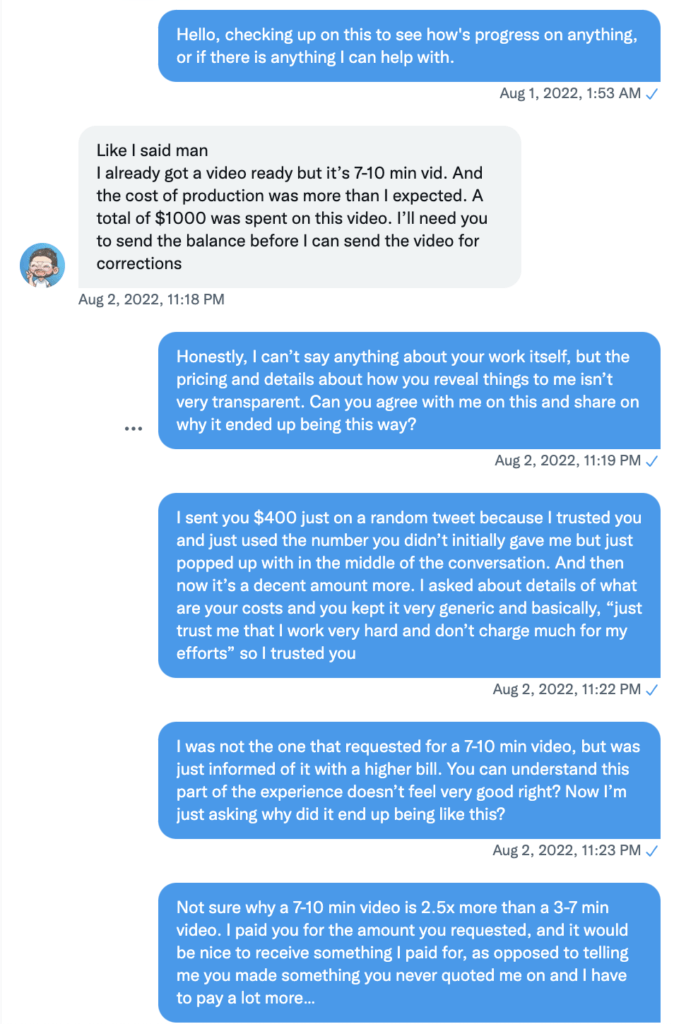
The Scam Investigation Begins…
At this point, I finally decided to do more research. One thing I noticed is that his Twitter Account, while very old with a decent amount of followers, basically just retweets stuff without having any original tweets.
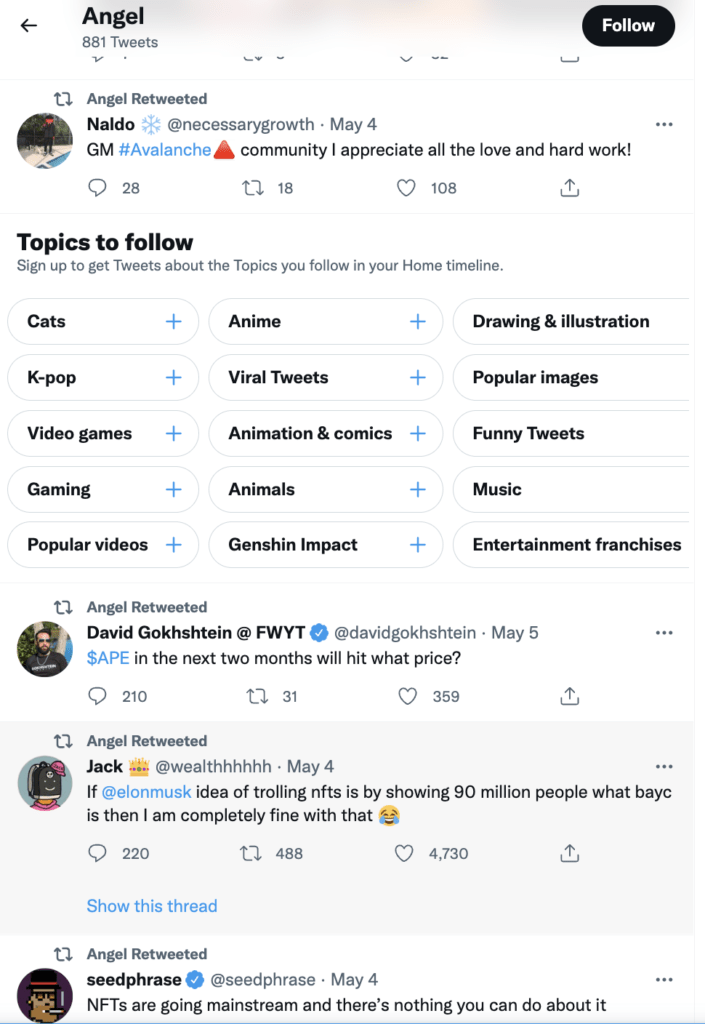
Kind of weird…where’s the personality of a Youtuber? That led me to ask him to show me a 3-5 second clip of what he has made, with him and my project there at the same time.
Then afterwards, I finally went to check out his channel more. I went to the About Channel section and found that it linked to his Twitter Account.
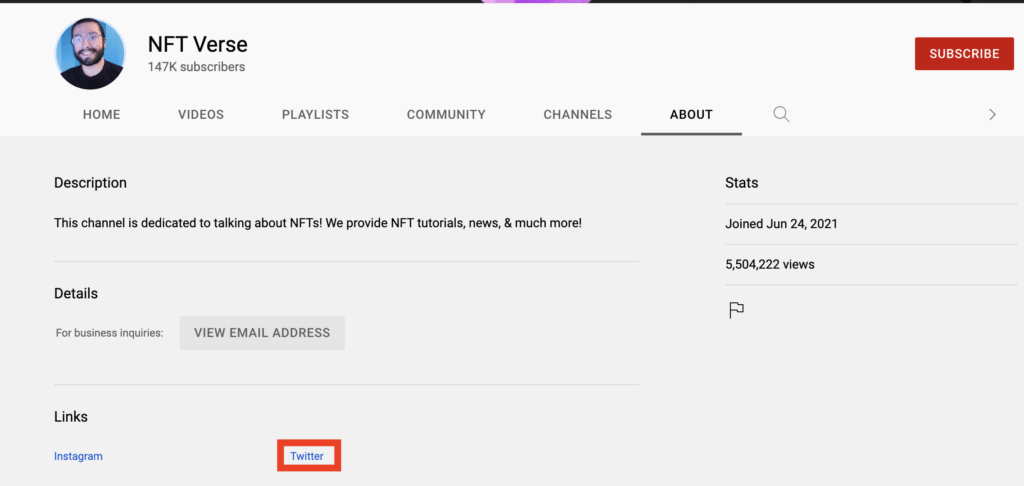
To my surprise, the Youtube points to a different but near-identical Twitter account.
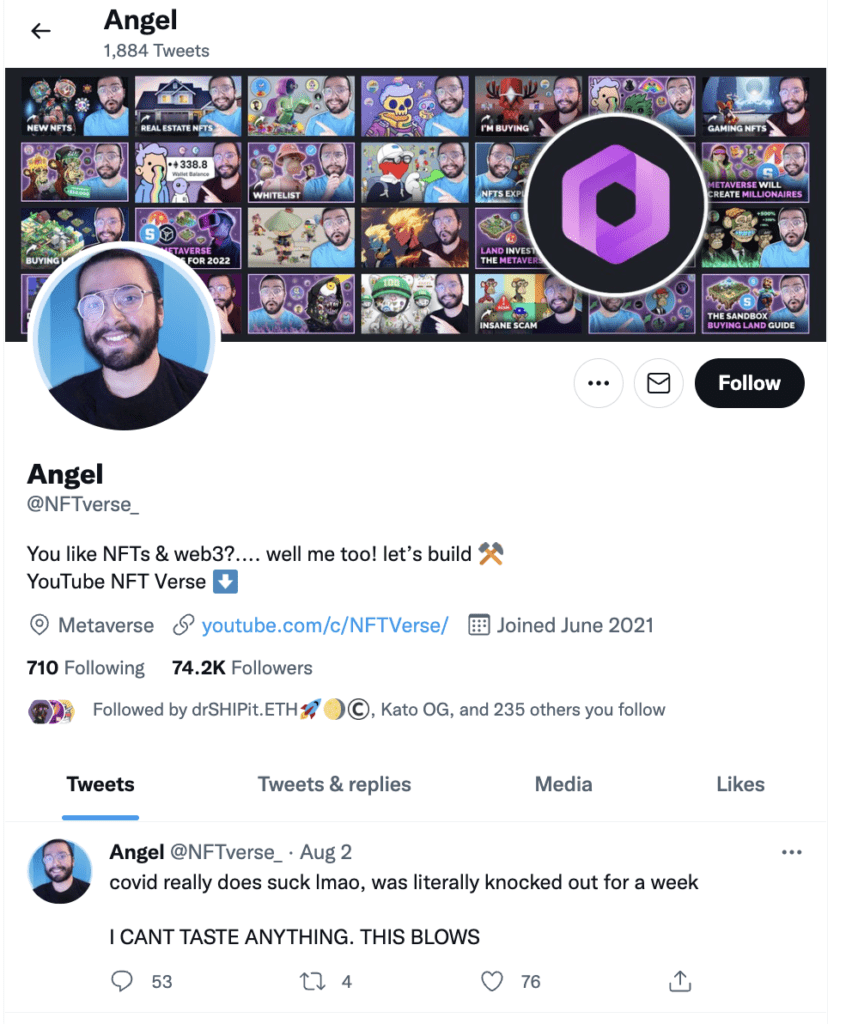
Uh-oh.
Oddly, even though the legitimate YouTuber Twitter Profile was way more social than the Scam Twitter Profile I was talking, it actually was created later (June 2021) compared to the Scammer’s account (Jan 2013)
The fake account was created before the real account??
This actually because the fake account was created earlier but had a different name, and the scammer later changed the name and Twitter ID to reflect whoever it wants to pretend to be – gaining trust in the process.
This is also why it’s imperative that Twitter bans these “old Scammer Accounts” as quickly as they can so scammers would at least show up with profiles that were just created the month before.
Just to be sure that this isn’t an alternative account for Youtubers to discuss business without others seeing it, I checked with that referenced account.
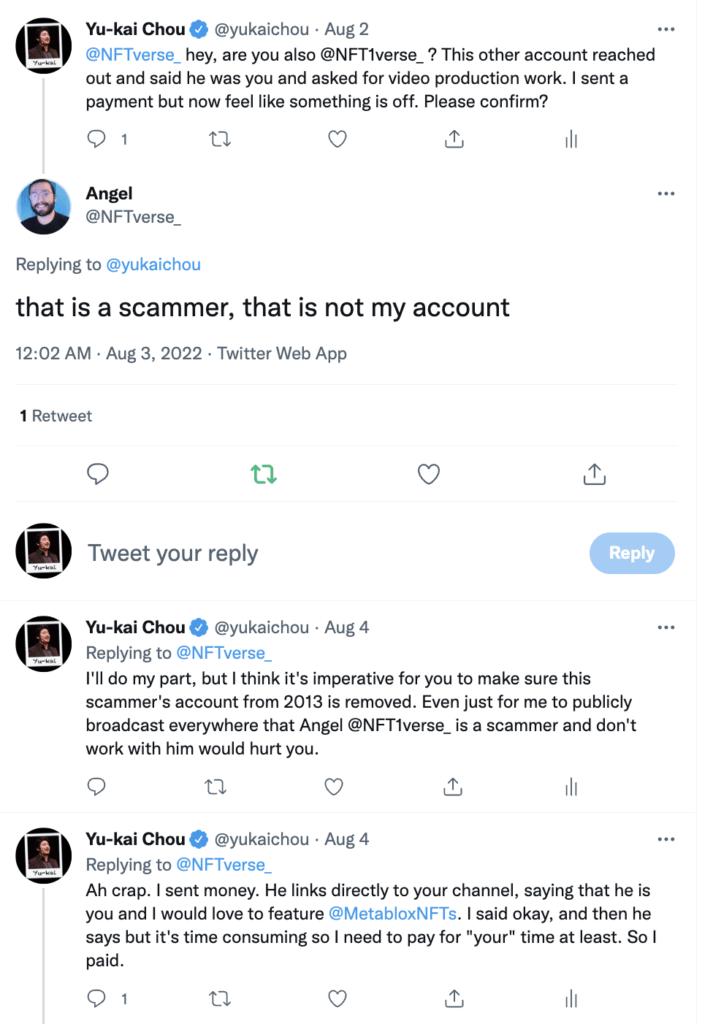
“Hey, are you also @NFT1verse_?”
“That is a scammer. That is not my account.”
So at that point, it’s 100% confirmed I got scammed $400 with danger of losing another $600. If I didn’t do all this investigating, I could very well fallen into the Sunk Cost Prison (Core Drive 8 in the Octalysis Framework) and just kept going.
Once I called out the scammer publicly, I immediately got blocked by the Twitter Spammer. I thought, “Well, just because the Twitter Scammer can’t see my tweets doesn’t mean the rest of the world can’t see me calling them out if they search his name.”

I also found a variety of other variations of the same YouTuber, all with the same tactics of just retweeting everything instead of having original tweets.
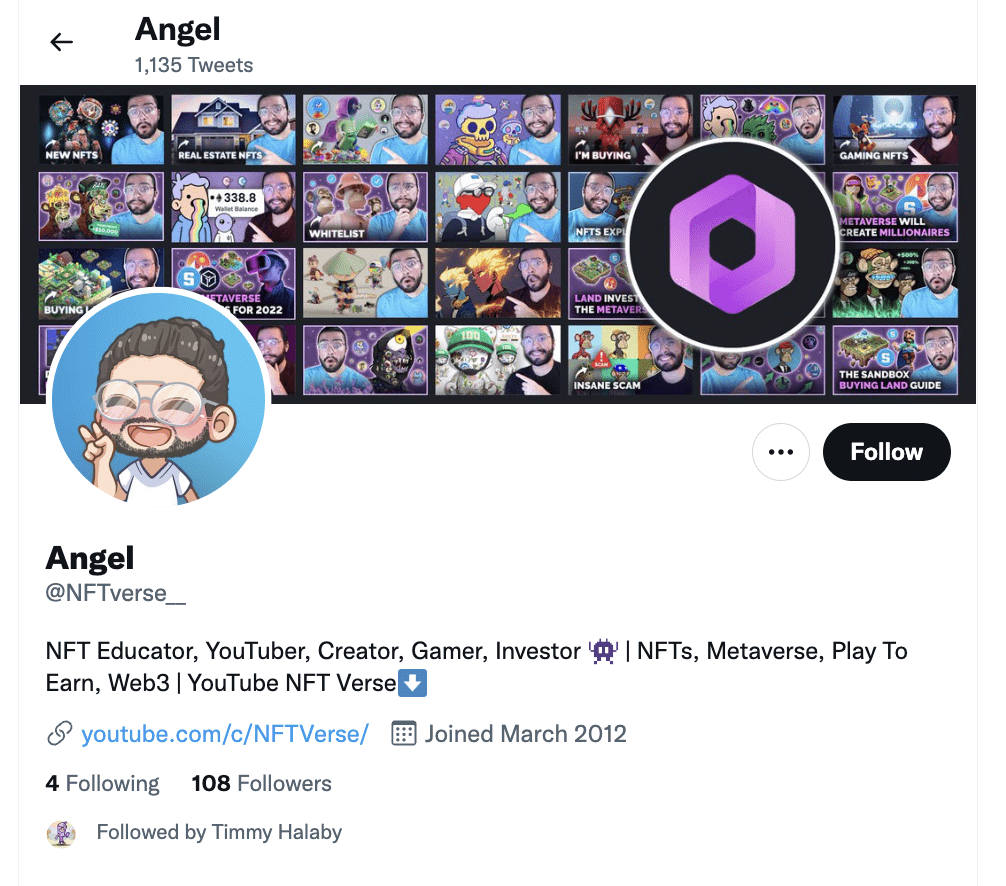
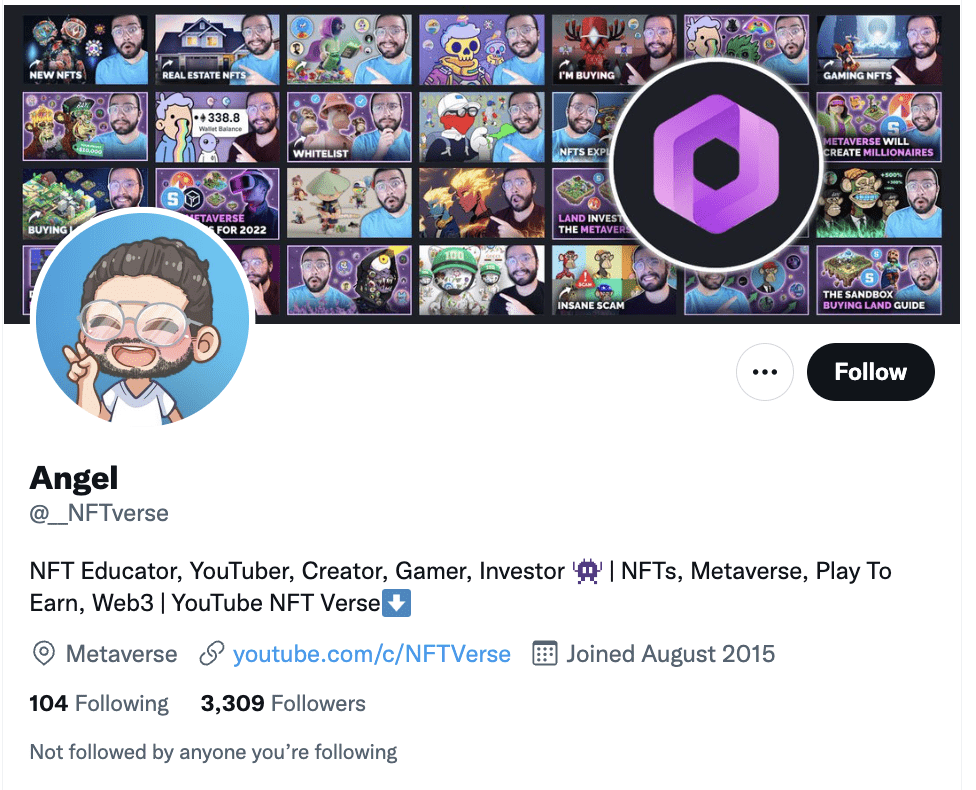
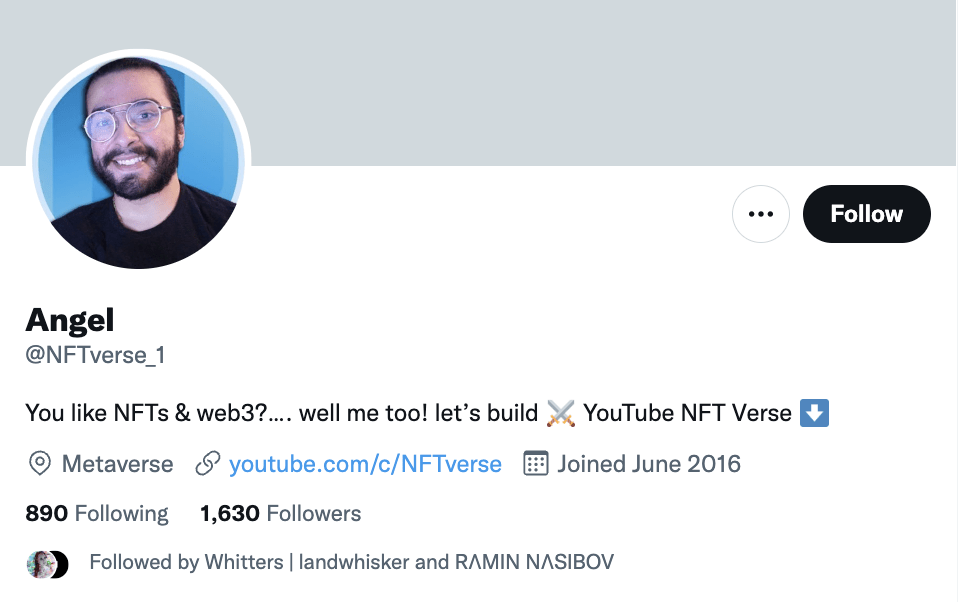
Notice ALL of these accounts were actually created beforethe real Twitter account they are trying to impersonate.
Again, that’s because the accounts were created very early on, and then they changed the Twitter Handle ID to become similar to the YouTuber they are pretending to be.
Also, the accounts likely used a service or manually added thousands or even tens of thousands of fake Twitter Followers to look legit and attractive. Many of the followers follow over a thousand people but have zero followers.
Twitter: Sorry – we don’t allow you to report scammers
So now that I’m down $400 and feeling humiliated/embarrassed, my next task is to protect others and make sure this scammer can never scam another soul again.
So I revisited the report function.
And here comes the next level of frustration.
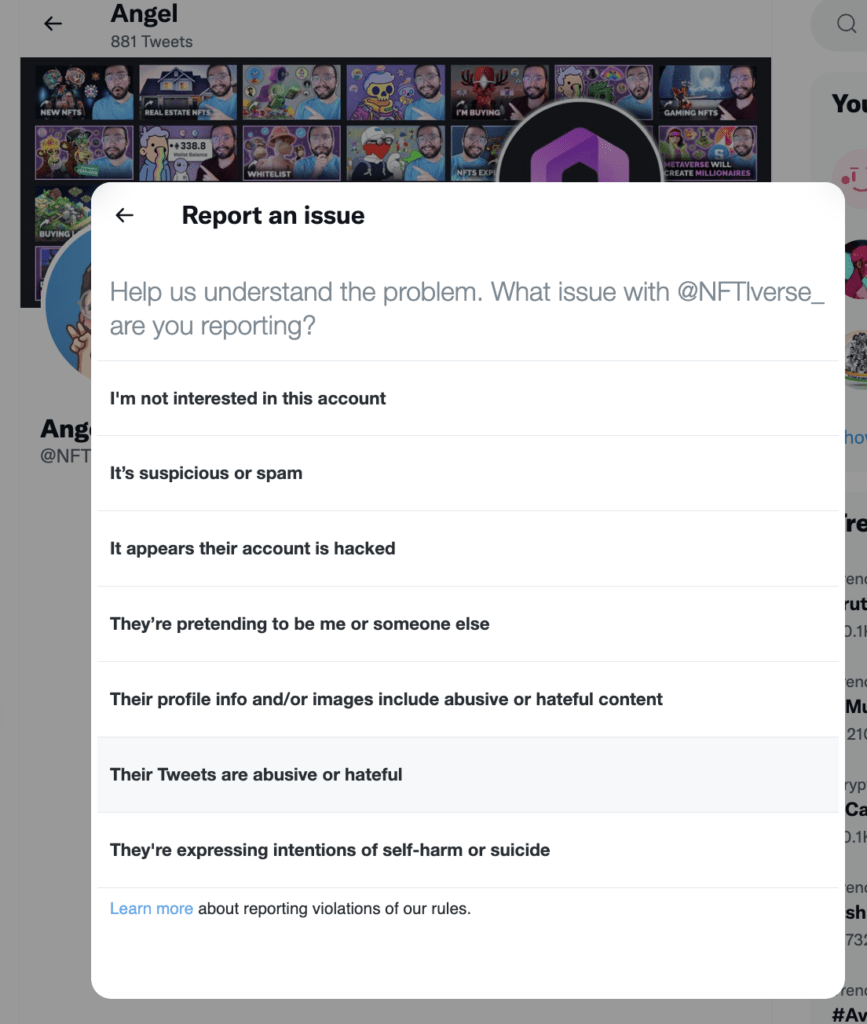
Still, nothing allowed me to report an actual malicious scam that is stealing money from other Twitter users.
I tried a variety of options, even trying to just find anywhere that I could include in the write up notes that this is a confirmed Scammer and should be removed immediately.
So from these options, we can safely eliminate: “I’m not interested” “Their account is hacked” “Abusive/Hateful Tweets” “Abusive/hateful Profile Info/Images” “Self-harm for suicide.”
If I tried “It’s suspicious or spam” because this confirmed scammer is….er….suspicious, this shows up.
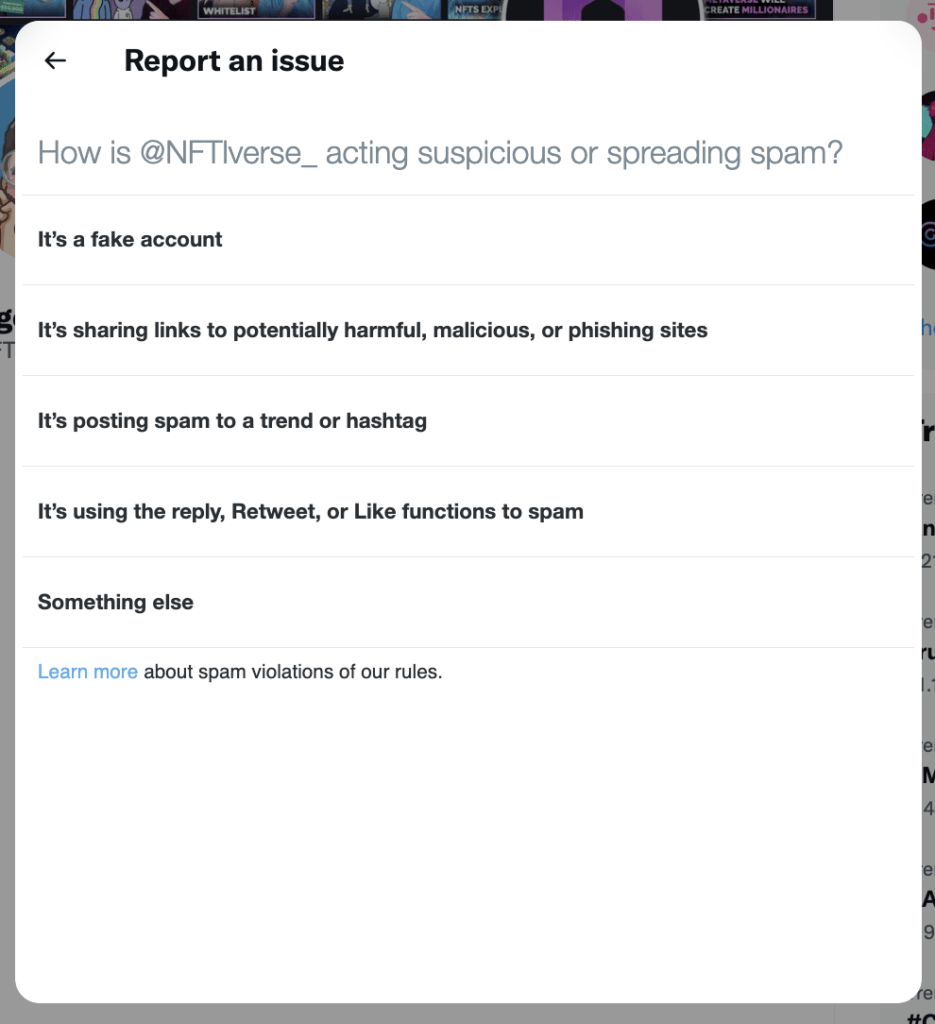
None of them show the seriousness of someone is being a scammer. If I tried, “It’s a fake account,” I get this screen:
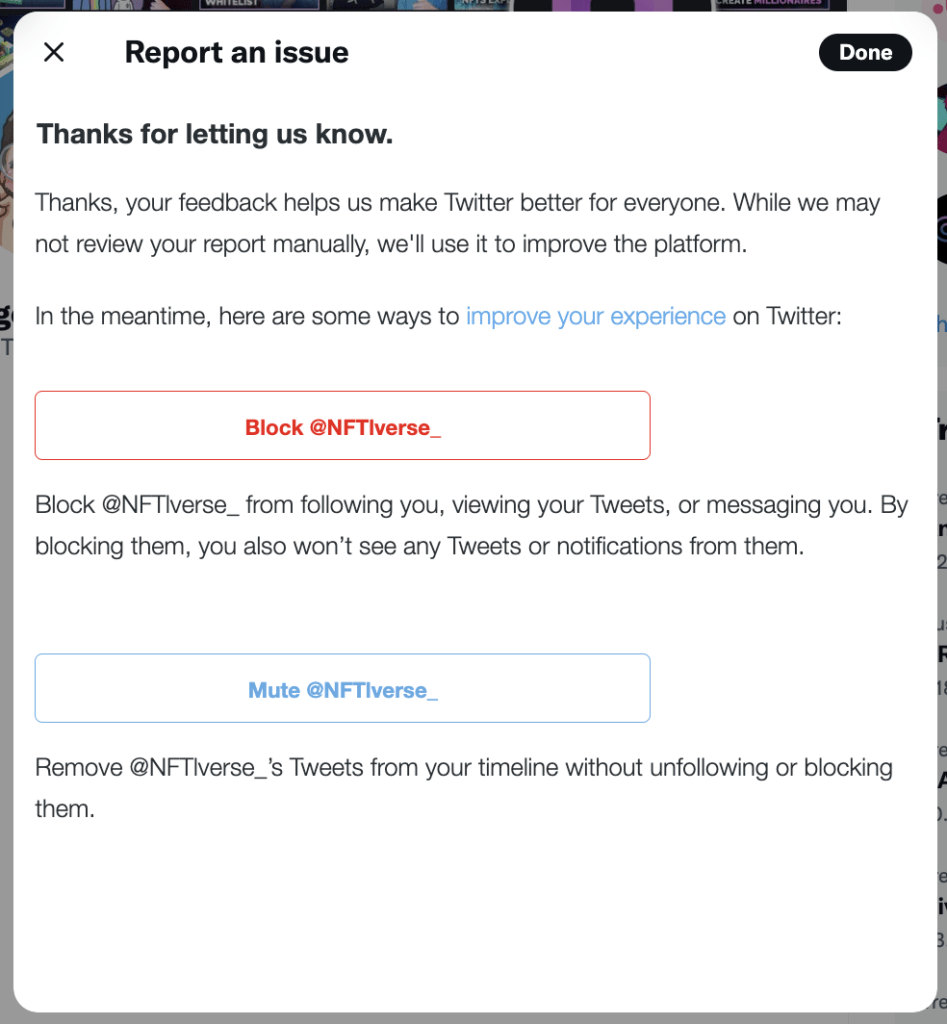
This basically tells me, “Thanks – we’ll kind of ignore that until we get a lot of users all reporting this person as fake. And THEN we may start an investigation on how they are fake. But fake isn’t illegal so we don’t care about it that much” (considering how many obviously fake profiles there are on Twitter).
So then I tried, “It’s sharing links to potentially harmful, malicious, or phishing sites.” I immediately get the “Thanks for letting us know. You can block this person” message, which means no scammer’s getting banned today.
And then I tried, “Something else,” thinking that for sure this will allow me to type “what’s that something else?” so I could yell, “SCAMMER!!”
But no, immediately, I’m on the same screen with
“Thanks for letting us know. Thanks, your feedback helps us make Twitter better for everyone. While we may not review your report manually, we’ll use it to improve the platform.“
So clearly, “suspicious” is getting me no where. Time to try something else.
“They appear to be hacked” immediately takes me to the “Thanks but we won’t really review this” page.
If I chose “Their Profile is abusive or hateful” than I also just get taken to the “Thanks for letting us know” page.
If I chose “Their Tweet is abusive or hateful”…because maybe scamming someone is considered abusive or hateful? I get this screen:
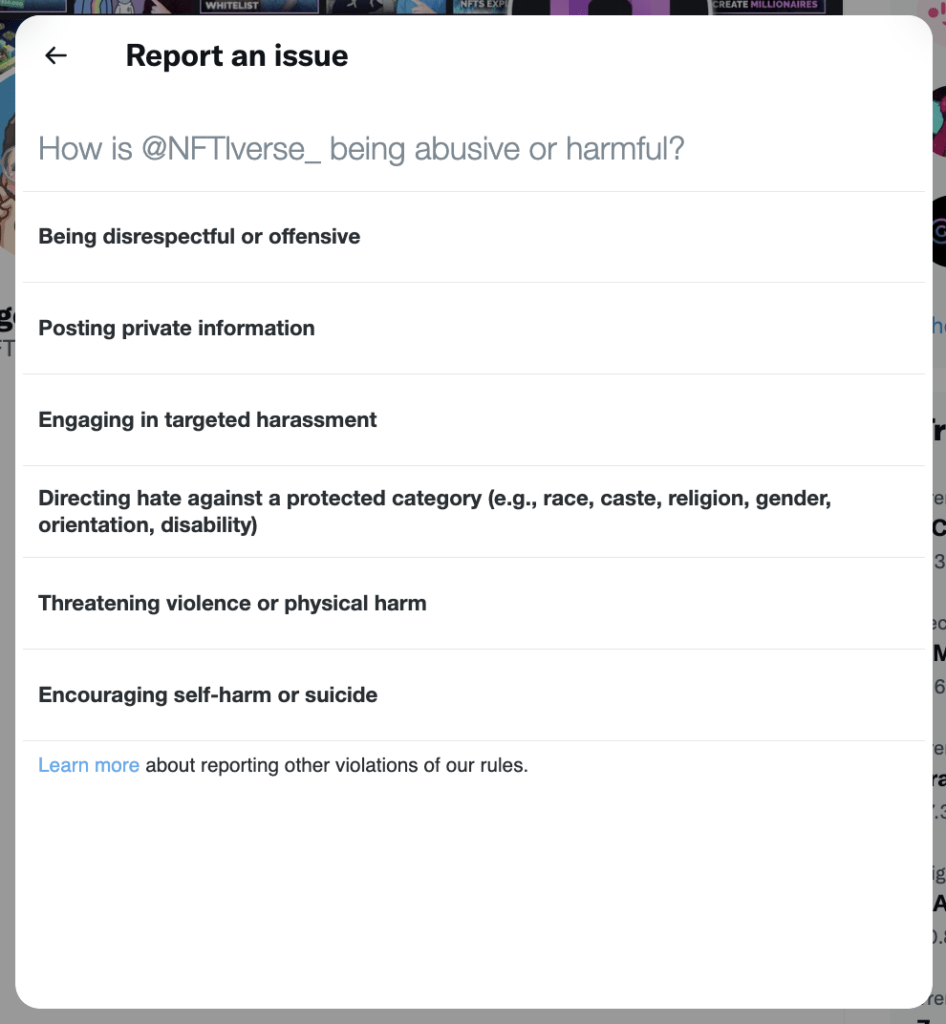
As you are aware, none of these options are perfect for what we want to do, but I first chose “Being disrespectful or offensive.” I immediately get this:
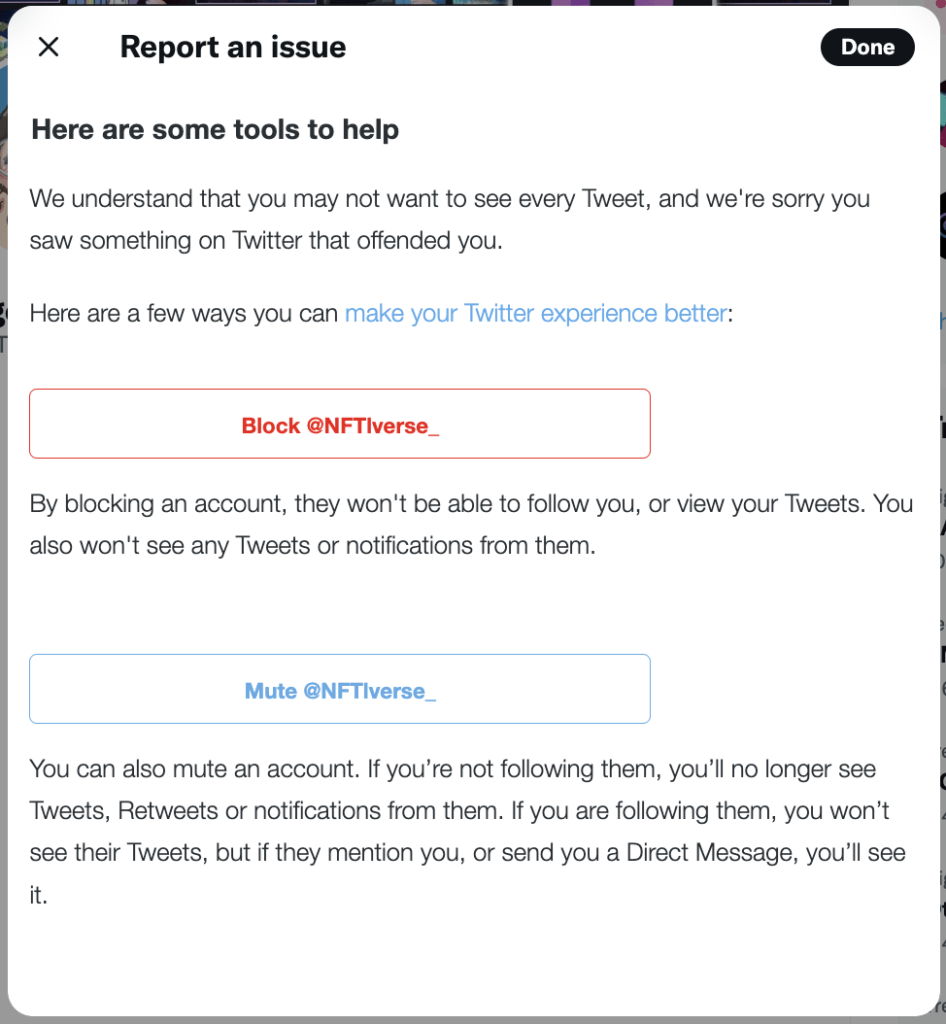
Oh, you can block and mute the person. Thanks. But it doesn’t prevent them from spamming other good people out there.
If I select “Engage with Targeted Harassment” I then get to choose “Who is this person targeting? You or someone else?” Since I was the one getting scammed, I decide to choose “myself.”
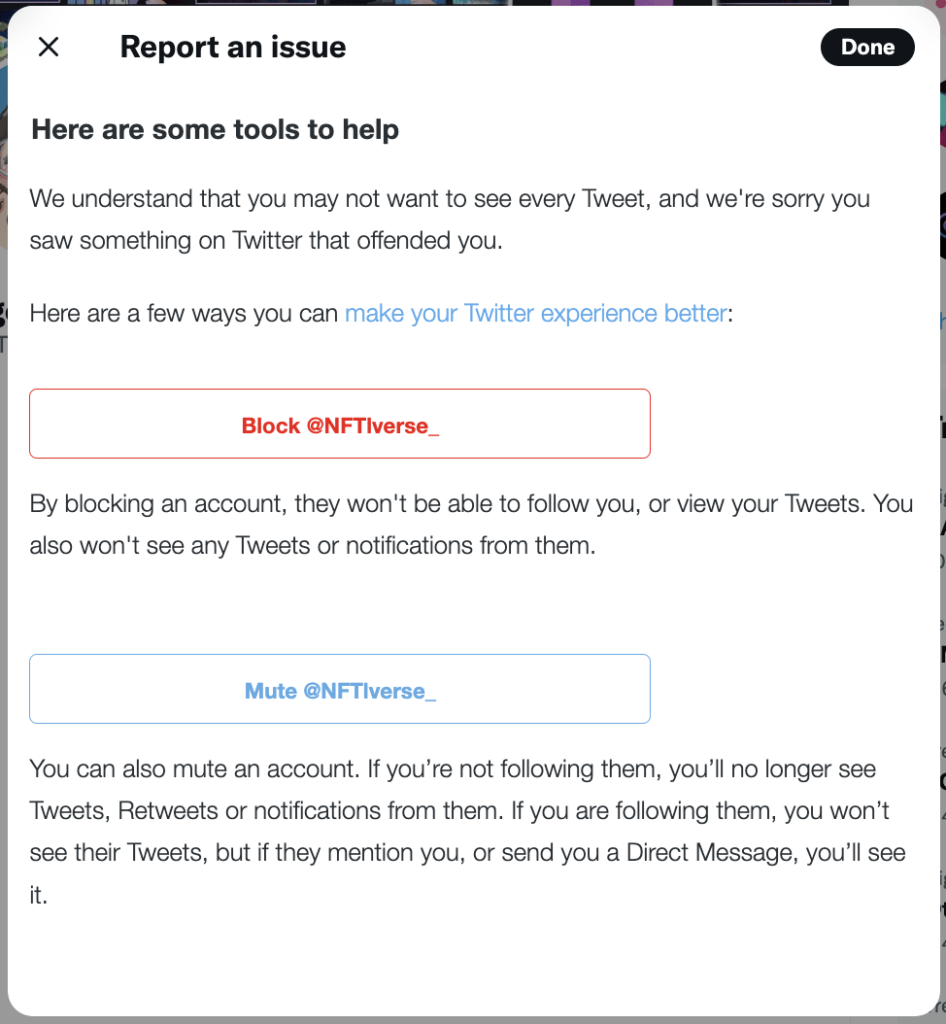
It then asks me to add 5 Tweets to show that I was harassed. Well, first of all, it was through DMs, not tweets, so I can’t see them.
But additionally, I WAS BLOCKED, so I cannot see Tweets to add either. Oops.
Finally, I choose the one that also seems appropriate but not harsh in anyway, “They’re pretending to be me or someone else.”
It then asks if they are pretending to be me or someone else. I choose someone else.
Here I can type who are they impersonating.
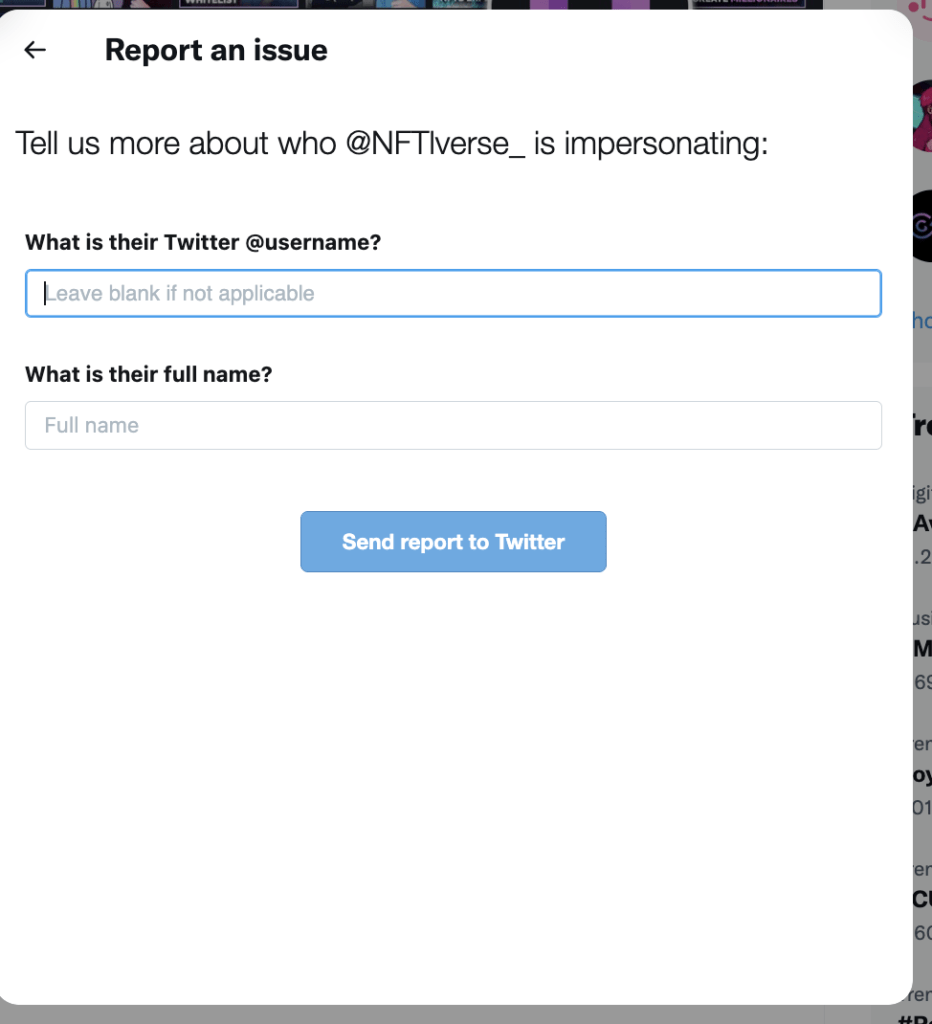
Here I input the actual YouTuber’s Twitter Profile. In the “Full Name” I put “Angel” as well as a whole sentence saying, “This person is a scammer and should be banned immedia…”
And I get the same, “Thanks for letting us know.”
I wished it worked a few weeks ago when I was doing it, but the fact that all these fake accounts are alive and kicking means that none of the actions above worked.
So after looking and trying through all the options, I finally gave up.
No I didn’t.
I realized it’s an even bigger problem that Twitter doesn’t allow people to report scammers and phishing attempts!
This problem that could affect tens of millions of people and the whole Twitter platform itself must be made aware so they could start cleaning the Twitter ecosystem.
I therefore went on LinkedIn, and found the VP of Product for Twitter. Surely this person could affect the adding of one simple reporting button.

So I wrote a message to him saying how I got scammer but reporting the scammer was impossible on Twitter (aka huge problem that affects everyone).
I’m case he doesn’t see the LinkedIn message, I found him on Twitter too to report the platform-damning flaw. His job is to lead the improvement of the Twitter Product, so surely he would see messages from a verified author on Twitter?

As of this writing, I still haven’t heard back from Keith Coleman but perhaps he would become aware of this issue and help push for some changes.
This blogpost is my last resort
I’ve lost hope on the matter and decided that writing this blogpost was the only way to get enough of Twitter’s attention if it gets shared by a lot of people.
Besides Tweeting regular warnings to my followers that I care about immensely regarding the Twitter Scammer and his multiple fake accounts, as well as pinging the amazing Internet Detective with integrity CoffeeZilla, the only thing I could hope for is this blogpost getting enough attention.

This baits more scammers on Twitter!
As if scamming Web3 entrepreneurs who want to promote their companies wasn’t dirty enough, some scammers directly target victims who were already scammed!
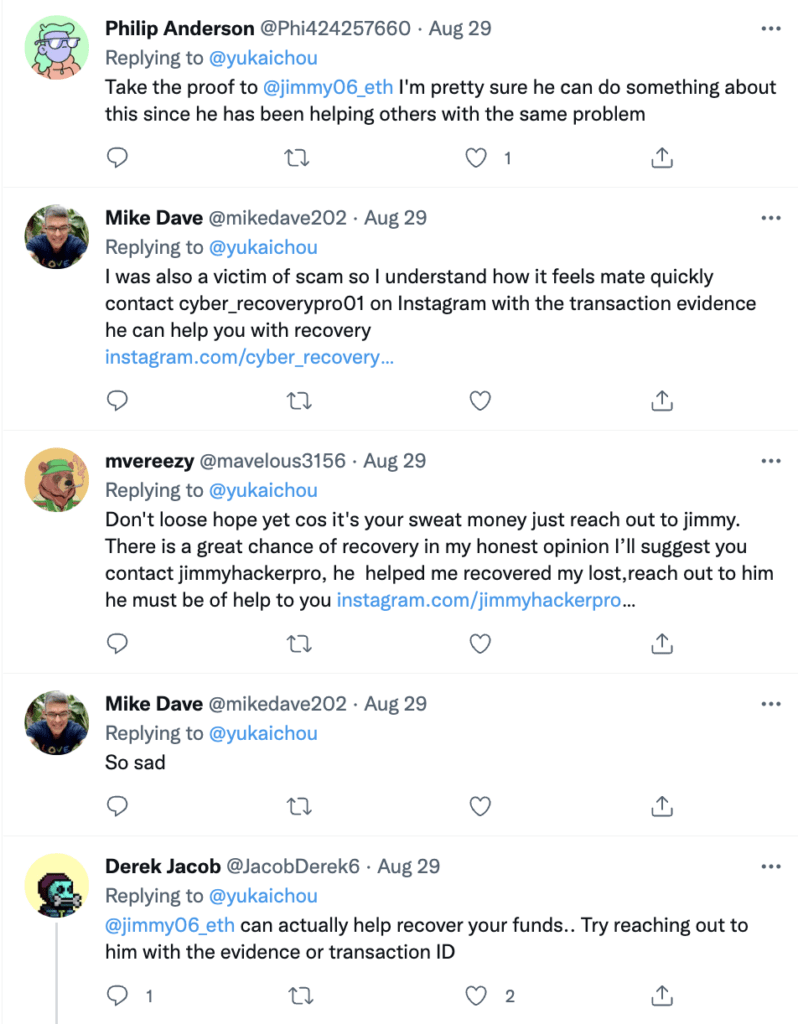
Somehow, my tweet about being scammed led to a group of Twitter Profiles tell me that I should contact some kind of Blockchain expert because they have been helped in the past and the person can get the money back for me.
“If you have proof of transaction he will track the wallet to Know if your funds are still recoverable (not all funds are recoverable”

So look, I don’t have full proof that these are scammers because I didn’t take up on their services. I can only say they are extremely suspicious because:
1) The friendly former customers look like bots
I noticed there is an army that IMMEDIATELY finds keyword terms of people being scammed and reach out saying, “Go contact this person! He will help you get your money back.”
So if anything, these are dedicated salespeople/bots pretending to be previous happy customers. That itself should make you stop trusting it.
2) (Mainstream) Cryptocurrency Transactions are irreversible
As far as my knowledge goes, a crypto transaction (on the main chains) are irreversible.
That’s the whole thing about Decentralization – you no longer trust big banks to manage and protect your money, and you take full responsibility for every transaction.
This is why scammers love stealing those with crypto wallets, and when there is a major theft event with Ethereum that disturbed the ecosystem, they couldn’t reverse it and had to fork out a new chain that pretends the theft didn’t happen (and the old chain became known as Ethereum Classic).

So yea – even though I don’t have proof, make sure you don’t fall victim to these “happy customers” who used an expert to reverse the funds that you got scammed, or else you might be scammed a second time!
Tips to protect yourself from Twitter Scammers
Okay, so for those who don’t care about my tragic story and the health of the Twitter ecosystem, I at least want you to know how to protect yourself from these Twitter Scammers.
1) Be triple careful on cryptocurrency payments
The first warning sign should be folks who want to get paid via cryptocurrency straight from Twitter without other validations.
Obviously, there is nothing wrong with payments on cryptocurrency itself. I too believe it’s the future of commerce.
But considering that wallets payments can be anonymous and irreversible, if you send it out to a scammer, there is no way to get the money back.
Therefore, scammers also like to use cryptocurrency as payments, much like Western Union.
Of course, if you are running a Web3 company like me, it’s normal that you will meet many service providers that want to collect with crypto.
Even my consulting/design company The Octalysis Group has encountered multiple clients who only want to pay with crypto or stablecoins.
If you must do business with a company that wants to collect with cryptocurrencies, make sure there is a legal contract in place.
Also make sure the contract is delivered through a proper email address related to that company. Don’t accept the contract from @gmail.com, but something like @octalysisgroup.com or @yukaichou.com.
Of course, you want to check if the websites are legitimate.
Even so, someone could possible create a scam domain name like TheOctalysisGroup.com or yukaichou.net and create a fake site to look legit. If the dollar amount is big, it is likely best to Google Search for the legitimate site, and then use their contact form to inquire about whether this person you are talking to is legit or not (most of the time, if it is not legit the company will escalate on the issue and reply quickly).
2) Avoid any Urgency Tactics or Scarcity Psychology
And truth be told, what really got me was the urgency of trying to pay when I thought the crypto prices were at a high point.
A sense of Urgency (driven by Core Drive 6: Scarcity in the Octalysis Framework) is one of the fundamental blocks of any scam.
If you believe you must act quickly (or else the IRS will come and arrest you, or your unauthorized bank transfer will no longer be reversed), you act hastily without your brain being able to think it through.
In my case, this urgency wasn’t even created by the scammer but my own greed (thinking I was clever) of wanting to pay quickly when the price of the Ether was high so when it might drop later I would get a better deal.
Normally, I would want to see a bit more from people before I paid. But since the amount of $400 was not excessive and due to wanting to be clever, I was the fool in the room.
Remember: when it comes to paying strangers for ANYTHING, don’t give yourself any sort of urgency.
Breathe in. Investigate. Then act.
3) Ignore any sentences that are meant to guilt you
Now keep in mind, the scammer would often use language to make you feel like an unreasonable person. I questioned the cost and the response made me feel like I was unreasonable for not trusting his quote.
Don’t fall for that. They want something from you, and it is never unreasonable to ask for more clarification.
At worst – the deal doesn’t go through and that’s okay.
Deals you are afraid to lose will also make you very vulnerable from being scammed, or at a minimum get yourself into a bad deal (Core Drive 8: Loss & Avoidance in the Octalysis Framework).
4) The Twitter Account just retweets other content
With all the accounts that this Twitter Scammer has, all of them only retweet other peoples’ content. You can see the real YouTuber’s account actually posting more social original tweets, such as getting COVID-19.
This is because it takes a lot of work to actually stay sociable and interesting on Twitter.
If a scammer is to maintain dozens or hundreds of fake Twitter Profiles (I can only imagine this same scammer is also using a lot of other YouTuber identities…because why not), the most scalable way is just to retweet other people to seem active, or have some service/script to do it for them.
Interestingly, one of the Scam Twitter Profiles exclusively retweets the real YouTube account, making it seem like this person is just tweeting normally and retweeting himself.

Here it just looks like “Fake Angel” is tweeting normally, maybe retweeting their own tweets, and getting a lot of social responses!
It takes a lot of clicking and investigating to realize that it’s a faker account constantly retweeting a more legitimate and sociable account.
5) The Twitter Profile talks like a foreign person
This is of course a bit unfair for all the legitimate foreign social media friends out there, much like saying payment with cryptocurrency is a red flag for scamming, but since we are just collecting little red flags here and there to protect people, it’s important to note any detectable clues early on.
If a Twitter Profile pretends to be a YouTuber with highly fluent English (you can watch their videos after all), but in their tweets they type as if English was a foreign language or they use unnaturally proper terms (like calling you “sir” or saying, “This food was very delicious.”) that’s a red flag.
In my case, the scammer talked normally and used an “American Dude” kind of language to engage me. I don’t think he is a foreign scammer but likely an American scamming others. That – or super well-trained by American colloquialisms and responses.
If they pose to be from the United States but reply in odd hours, it could just mean they are traveling or staying up in weird hours like 3am, but it is also a potential warning flag.
6) Rudely ignoring or deflecting small talk
If you ask people about some details about how they are doing, recent events, or details of their requests, and they either outright ignore your small talk or show impatience, it’s also a red flag.
My scammer showed they were being offended when I questioned if he was being paid too much for the amount of time he would spend while wanting more details.
Previously I felt that scammers would act politely in order to maximize their chance of getting your money and avoid the risk of pissing you off.
Now I know the reverse psychology of “how dare you question my integrity” actually works quite well too.
7) If the Twitter Profile pushes for a lot of urgency
Of course, this is very similar to (2) – one is how you should avoid urgent psychology while this is an actual red flag for someone who might be a scammer. Since this point is so important I don’t feel bad reiterating on it.
If the Twitter Profile is pushing you to send money quickly, either through some integrated mechanic like negative consequences if you don’t, or just pushing you whenever you are slow, it’s another red flag that this might be a Twitter Scammer.
Of course, in my case, the Twitter Scammer was actually quite patient! Besides my own urgency of paying quickly, he didn’t follow up regularly (granted, he already got my first payment), and even ending conversations with, “Oh!” and not following up for weeks.
But generally, if you notice the person pushing really hard, consider it a red flag too.
8) Check all the sources they reference and see if it references back.
This is huge and how I ultimately realized it’s a scam. If they say they are a YouTuber, go to that account and see if the account promotes any Twitter Profiles (sometimes it’s in the videos themselves).
If it’s not the same as the profile you are talking to, 90% it’s a scam.
This is the same principle as getting calls or mail from a reputable business asking you to pay fees.
The best way is to hang up and call their official number to see if this is legitimate or not. Check their official websites, look at the email accounts they are sending info with.
Always look at the sources they claim to be affiliated with and check if it connects back to this individual you are communicating with.
Conclusion: Twitter Scams are the worst, and Twitter needs to get rid of them to thrive
I love Twitter as much as anyone reading this blogpost (and Elon Musk for that matter). But the plethora of bots and scammers (“Elon Musk is giving away free bitcoins!”) that festers in the ecosystem will eventually tear everything down.
As individuals, I encourage you to stay vigilant, spot the Twitter Scammers, share this blogpost with anyone you care about, and push Twitter to do something about it.
If you work at Twitter, or know people who work there, please let them know about what’s going on here so they would quickly introduce a “report as scam” option as soon as possible and confirmed scammers are immediately banned.
I not only lost $400 and emotional damage from being scammed, as you can tell I also spent A TON of time writing this blogpost and documenting all the heartbreaking steps in the process.
If no one ends up reading this post, I would have lost all that time too. So please, please, help spread this post to those you care about and people at Twitter. I hope we can see transformational change and no one ever needs to be scammed on Twitter again.
Update: hilariously enough, the moment I shared this blogpost on Twitter, I get hit by other bots telling me to contact other spammers on Instagram…stay safe and vigilant folks!
